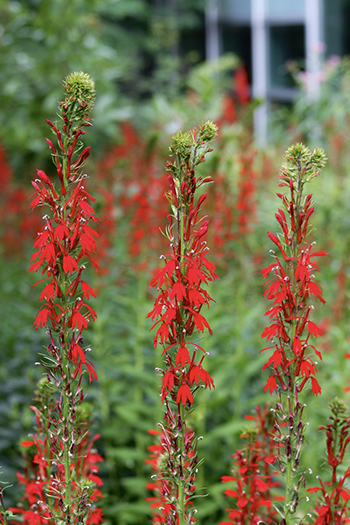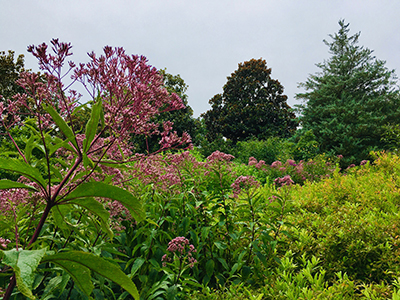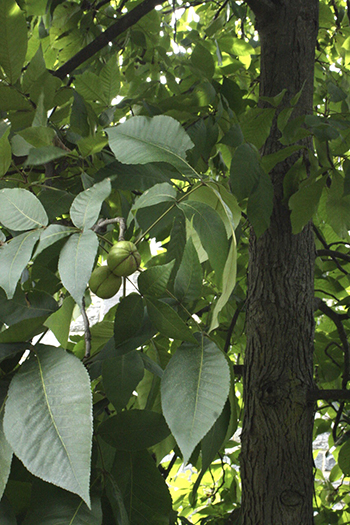
Plants of the Week: August 23
Guest Author: Julia Hackstie

Tall spires of Lobelia cardinalis (cardinal flower) will greet you this week as you step down into the Glade Garden. Sit a while to enjoy the quiet stillness of this garden, and you will see hummingbirds come to feed on the nectar inside the bright red tubular flowers of the 3-6 foot tall racemes. Lobelia cardinalis relies on hummingbirds for pollination since other pollinators find its flower structure awkward to navigate. Preferring consistently moist soils, it does well in sun but can take a good deal of shade. This would be another perfect addition to a rain and/or pollinator garden. Lobelia cardinalis and its feathered visitors can also be enjoyed along the side of the Wister Center. Photo credit: J. Hackstie

At the foot of the BioStream, masses of Eutrochium maculatum ‘Gateway’ (Joe Pye weed) are currently in bloom. A long-blooming perennial native to Eastern North America, blooms of dark mauve-pink flowers sit atop deep red stems with whorled leaves. It seems to always be covered in skippers and butterflies, so this would be a great addition to your pollinator garden or at the back of the border. It pairs stunningly with other native perennials and grasses such as Schizachyrium scoparium (little bluestem).
Growing 4-5 feet tall, this cultivar is slightly shorter than the species, is bushier, more compact, and has fuller inflorescences. It prefers full sun and consistently moist, fertile soils and will benefit from division every 4-5 years. Not only do the seeds attract seed-eating birds like the American goldfinch, but the seed heads provide beautiful winter interest, so simply leave plants standing at the end of the season. Photo credit: J. Hackstie

Walking past the Carya ovata (shagbark hickory) in front of the Science Center, it’s hard to miss the large light-green fruits that are forming on its branches. Once autumn arrives, these thick segmented shells will darken and encase edible nuts. These fruits are enjoyed by mammals and birds alike. I’m always drawn to the upward-peeling, thickly shaved bark of this tree when it matures, which interestingly, can provide nooks for bats to roost. Shagbark hickory is a climax species of the hardwood forests of Eastern North America and hosts the caterpillars of many butterflies and moths and provides cover to birds and mammals.
Come autumn, the pinnately compound leaves will turn golden yellow. Long-lived and growing up to 100 feet tall, this is a fine choice for a shade tree, however keep in mind that a tree must reach 40 years of age before producing fruit. Boasting attractive looks in combination with providing important ecological services, one can see why you’d want this tree as centerpiece in your yard for decades to come. Photo credit: J. Hackstie





No Comments